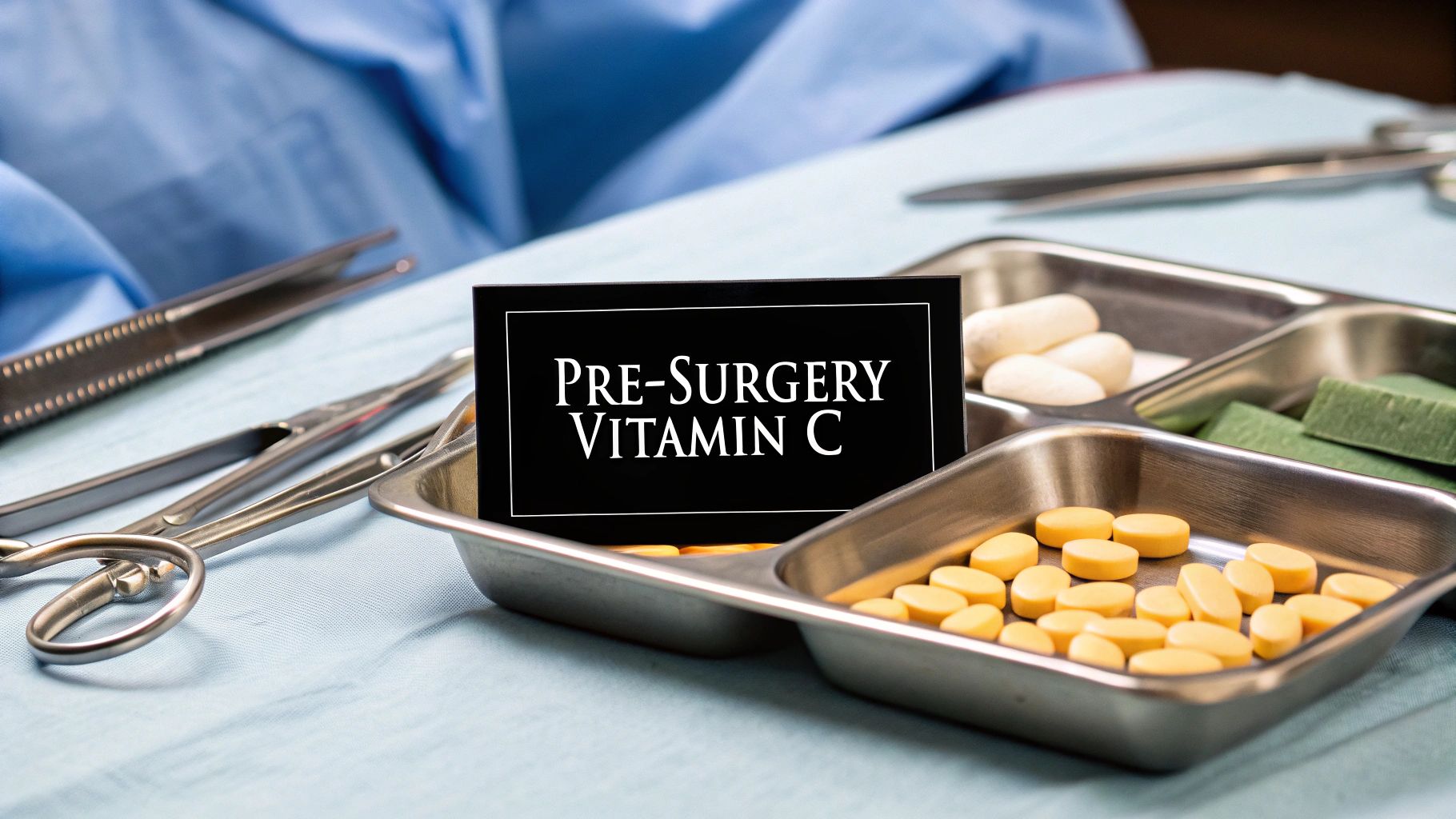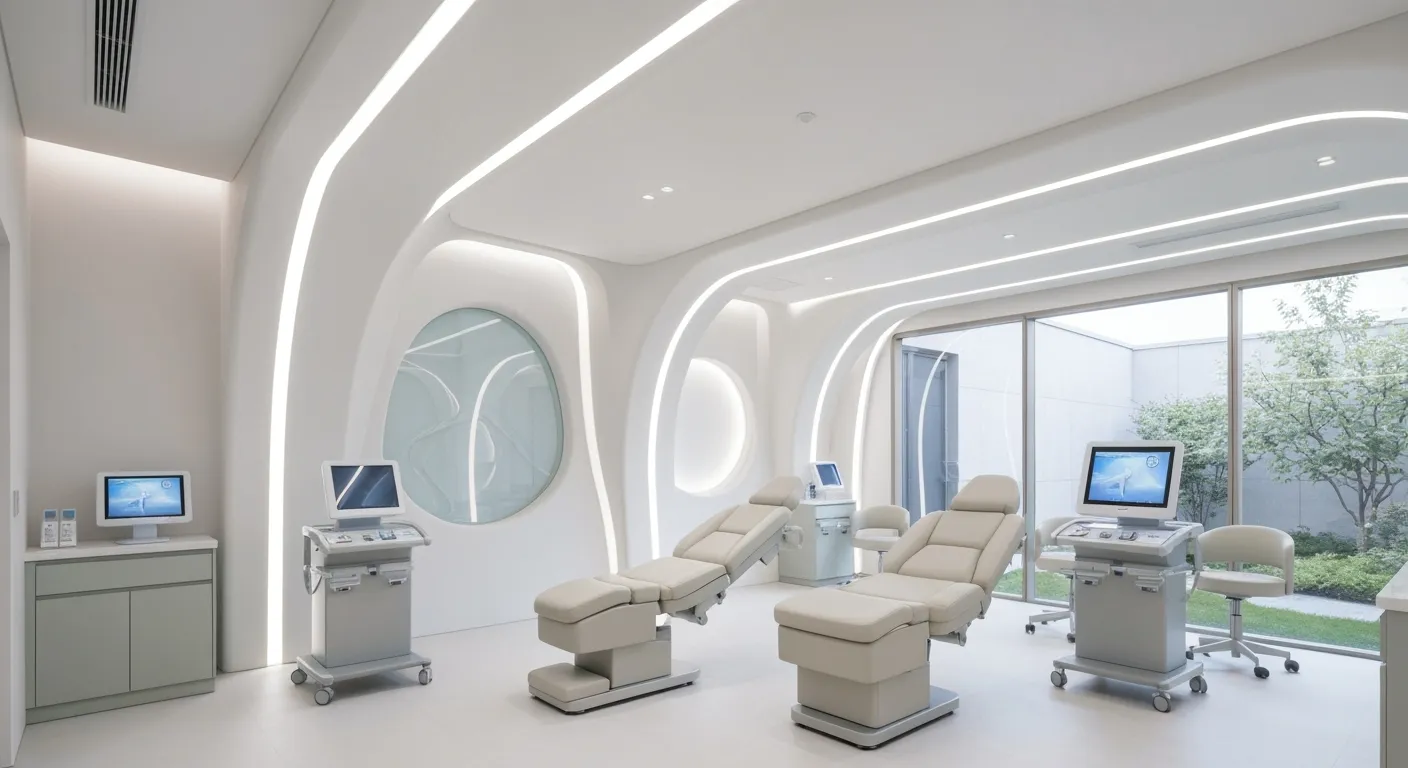
November 22, 2025
Taking Vitamin C Before Surgery An Expert Guide
Considering vitamin C before surgery? This guide covers the science-backed benefits for healing, potential risks, and crucial advice from surgeons.
Oct 8, 2025

Body contouring offers a transformative approach for individuals seeking to reshape their bodies by targeting areas resistant to diet and exercise. Whether through surgical or nonsurgical methods, these procedures aim to improve body shape, enhance skin tightness, and boost self-confidence. This article explores the diverse techniques, the advantages, safety considerations, recovery processes, and candidacy criteria, providing a comprehensive guide to safely reshape your figure.
Body contouring refers to various surgical and nonsurgical procedures designed to reshape and enhance the body's silhouette. Its main goal is to remove excess fat and skin, tighten loose tissues, and improve overall body proportion. This makes the body look smoother, more toned, and more balanced. Usually, body contouring is sought after significant weight loss, pregnancy, or aging, especially when diet and exercise alone cannot achieve the desired results. Surgical options include treatments like tummy tucks, liposuction, body lifts, and arm or thigh lifts. Nonsurgical methods utilize techniques such as cryolipolysis (fat freezing), laser lipolysis, and radiofrequency treatments, which target stubborn fat deposits without incisions. The primary purpose of these procedures is to correct localized fat pockets and sagging skin, helping individuals feel more confident about their body image. It's important to note that body contouring is not a substitute for weight loss but focuses on refining body shape and contours. For more information, see Body Contouring Overview.
Body contouring reshapes the body by physically removing or reducing excess fat, tightening loose or sagging skin, and sometimes sculpting underlying tissues. Surgical methods like liposuction physically suction out fat deposits, creating a more streamlined and proportionate appearance. Non-invasive approaches, such as cryolipolysis, use cold temperatures to kill fat cells gradually. These cells are then naturally eliminated by the body's immune system, leading to a reduction in fat bulges over weeks. Thanks to these techniques, the body can achieve a more sculpted silhouette, improve symmetry, and highlight natural contours. For example, target areas like the abdomen, thighs, arms, neck, and hips can be refined to produce a more youthful and athletic look, as detailed in Body Contouring Target Areas. Body contouring enhances proportions and can help correct unevenness caused by weight fluctuations or aging, thereby improving overall body harmony.
While both aim to improve appearance, weight loss and body contouring serve different purposes. Weight loss involves reducing overall body fat through lifestyle changes like diet and exercise and often results in a lower body weight. Body contouring, however, is focused on shaping specific areas to correct imperfections such as excess skin or stubborn fat that resist diet and exercise. Most procedures do not significantly change overall weight but improve body contours and proportions. In many cases, body contouring follows weight loss to help achieve a more toned and sculpted appearance. It is suitable for individuals who are near their ideal weight but struggle with localized fat deposits or loose skin. Overall, body contouring complements weight management by refining body shape and boosting confidence, especially when weight reduction alone isn't enough. For additional insights, refer to Body Contouring vs Weight Loss.

Body contouring procedures are diverse, designed to address different aesthetic goals through both surgical body contouring options and nonsurgical body contouring methods. Surgical techniques are more invasive and tend to produce more immediate and dramatic changes. Common surgical options include liposuction, which physically removes stubborn fat deposits through small incisions, and body lifts or tucks like tummy tucks (abdominoplasty), arm lifts, and thigh lifts, which involve removing excess skin and tightening tissues. These procedures usually require anesthesia, significant recovery time, and careful planning, but they offer long-lasting improvements in body shape.
On the other hand, nonsurgical approaches use advanced technologies to reshape the body with minimal discomfort and downtime. Techniques such as cryolipolysis (commonly known as CoolSculpting®), utilizes cold temperatures to selectively freeze and destroy fat cells. Radiofrequency devices generate controlled heat to tighten skin and reduce fat, while laser lipolysis employs laser energy to break down fat deposits. Injection lipolysis, involving substances like deoxycholic acid, dissolves fat in targeted areas.
The main difference lies in the invasiveness of the procedures and the length of recovery. Surgical options typically involve longer healing periods ranging from weeks to months, and are suitable for significant body remodeling. Nonsurgical methods often require multiple sessions, lasting from 30 minutes to an hour, with most patients able to return to daily activities immediately afterward. While surgical procedures tend to deliver more noticeable and lasting results, nonsurgical treatments are ideal for subtle body shaping and maintenance.
Ultimately, choosing between surgical and nonsurgical options depends on individual goals, health status, the area being treated, and consultation with a qualified healthcare professional. Both approaches aim to improve body contours, boost confidence, and help patients achieve a more toned and youthful appearance.

Body contouring treatments provide a variety of physical, aesthetic, and emotional benefits that can significantly improve a person's quality of life. One of the primary advantages is the enhancement of body shape and contour. These procedures are highly effective at removing stubborn fat deposits that often resist diet and exercise, resulting in a smoother, more toned, and youthful appearance (Benefits of Body Contouring, Benefits of Body Contouring, Benefits of Body Sculpting).
In addition to improving aesthetics, body contouring can tighten loose skin, which is especially beneficial after significant weight loss or aging. The outcomes include a more proportionate silhouette, which enhances overall body harmony and boosts self-confidence (Body contouring after weight loss, Body Contouring for Aging Skin).
Nonsurgical options like CoolSculpting or laser lipolysis offer targeted fat reduction without the need for incisions. These treatments typically involve minimal downtime, allowing patients to return to their normal routines immediately. The results develop gradually over weeks, providing discreet and natural-looking improvements (Nonsurgical Body Contouring Methods, Non-surgical fat reduction treatments, Non-surgical Body Contouring Benefits).
For those seeking more dramatic and immediate changes, surgical procedures such as liposuction, tummy tuck, or body lifts deliver long-lasting and more pronounced effects. These surgeries are performed in controlled medical settings with the ability to precisely reshape specific areas (Surgical Body Contouring Options, Body contouring surgery, Body contouring procedures).
Beyond the physical improvements, body contouring enhances emotional and psychological well-being. Reducing excess skin and fat can alleviate discomfort caused by chafing, irritation, or restricted movement. It can also improve clothing fit and reduce self-consciousness, leading to increased confidence. Many patients experience a renewed motivation to pursue healthier habits and maintain their results (Benefits of Body Contouring, Body Sculpting Benefits).
While the benefits are substantial, it is vital to choose qualified, experienced healthcare professionals to ensure safety and optimal outcomes. When done correctly, body contouring treatments can transform both appearance and self-esteem, providing lasting satisfaction and a more vibrant, confident lifestyle (Body contouring safety).

Body contouring procedures involve both surgical body contouring options and nonsurgical body contouring methods, each with its own safety profile. Preoperative assessments are crucial; these include detailed reviews of medical history, current health, and expectations (Pre-procedure consultation for body contouring). Surgical options like lifts and liposuction carry risks such as infection, bleeding, scarring, nerve or tissue damage, anesthesia complications, and poor wound healing (Surgical risks and complications). These risks can lead to contour irregularities, persistent pain, or skin loss, especially if performed by unqualified practitioners (Body contouring complications, Body contouring surgery safety).
Nonsurgical methods, such as cryolipolysis (CoolSculpting®) or laser lipolysis, generally present fewer risks. Common side effects include temporary skin irritation, redness, swelling, or dissatisfaction with results (Side effects of body contouring). While rare, more serious complications like deep vein thrombosis, pulmonary embolism, paradoxical adipose hyperplasia (fat growth in treated areas), or unwanted scarring can occur and may necessitate further interventions (Cryolipolysis risks and complications, Body contouring risks).
Ensuring that procedures are performed by experienced, credentialed healthcare professionals in certified facilities is fundamental (Board-certified plastic surgeons for body contouring). Patients should also be fully informed of potential risks through detailed consent forms to ensure safe outcomes (Pre-surgery patient consent).
The FDA oversees the safety and efficacy of body contouring devices through its Center for Devices and Radiological Health (CDRH) (FDA regulation of body contouring devices). Devices such as cryolipolysis (CoolSculpting®), radiofrequency systems, and laser treatments are classified primarily as Class II medical devices, requiring premarket clearance before their sale and use. Manufacturers must provide substantial clinical or nonclinical evidence demonstrating safety, effectiveness, and proper labeling (FDA Safety and Effectiveness Review).
These procedures are not FDA-approved for treating obesity or breast tissue removal (Limitations of Body Contouring). Before use, providers should verify that their devices are FDA-cleared or approved, which guarantees adherence to safety standards. Additionally, the FDA enforces regulations requiring adverse event reporting, quality controls, and labeling standards (Reporting adverse device events).
Healthcare practitioners must undergo proper training and certification to operate these devices safely (Consulting healthcare providers before procedures). Consumers are encouraged to consult qualified providers who prioritize safety and use approved technologies. The FDA also warns against illegal practices such as injecting unapproved substances, which can pose significant health risks (FDA warnings against unapproved injections).
This regulatory framework aims to minimize adverse effects and promote safe, effective body contouring treatments while guiding consumers towards reputable providers and approved devices (Body contouring patient safety).

Recovery after body contouring procedures varies significantly based on the specific type of procedure performed. Surgical treatments, such as tummy tucks, lifts, and liposuction, often require several weeks to months for full recovery. Patients generally need to rest, limit strenuous activities, and wear compression garments to reduce swelling and support healing. Incisions are carefully dressed, and in many cases, drainage tubes are placed to prevent fluid accumulation.
Post-operative instructions typically include keeping wounds clean, taking prescribed medications to manage pain and prevent infection, and avoiding activities that may strain or displace healing tissues, such as bending, heavy lifting, or vigorous exercise. Early walking is encouraged to improve circulation and reduce the risk of blood clots.
Swelling, bruising, and discomfort are common initially, but these symptoms gradually lessen. Scars from surgical procedures tend to mature over months, with some scars fading considerably with time. Patients are usually advised to avoid soaking in hot tubs, swimming pools, or baths until incisions are fully healed.
Follow-up visits with the healthcare provider are crucial for monitoring healing progress, removing stitches if necessary, and addressing any concerns promptly. Consistent check-ins help detect potential complications early, such as infections, wound healing issues, or abnormal scarring.
In contrast, nonsurgical treatments generally have minimal downtime. Patients can often resume normal activities immediately after the session, with only mild swelling or redness that resolves quickly. Regular monitoring and adherence to post-treatment care guidelines help maintain optimal results and prevent minor issues from becoming more serious.
In summary, diligent care, calm activity resumption, hydration, and close medical supervision are essential components of a successful recovery following body contouring, ensuring results are both effective and lasting.
Suitable candidates are adults who have reached a stable weight, generally at least three months after significant weight loss or pregnancy. They should have excess skin or localized fat deposits that haven't responded to diet and exercise. Good health, nonsmoking status, and the absence of medical conditions impairing healing are essential criteria. These individuals often experience issues like skin chafing, infections, and emotional distress due to excess skin. They should also be committed to maintaining a healthy lifestyle, including proper nutrition and regular physical activity.
Before proceeding, a thorough evaluation by a board-certified plastic surgeon is crucial. This assessment includes reviewing medical history, checking skin elasticity, and examining the specific areas targeted for treatment. The perfect candidate is motivated to follow medical advice, which may involve quitting smoking and stabilizing weight, to minimize risks and enhance results.
Setting realistic goals is vital for satisfactory outcomes. Body contouring aims to improve body shape and manage excess skin or stubborn fat, not to serve as a weight-loss method. Patients should understand that while surgical procedures can produce immediate and significant changes, nonsurgical options often yield subtle results that develop gradually.
Maintaining a healthy lifestyle post-treatment is essential to preserve results. Weight fluctuations can affect the longevity of the outcomes, especially for less invasive procedures. Patients must be willing to adopt ongoing habits of balanced eating, regular exercise, and avoiding smoking.
Surgical procedures like liposuction and lifts are typically suited for individuals with considerable excess skin or fat and who desire rapid, noticeable results. These methods involve incisions, anesthesia, longer recovery periods (weeks to months), and higher risks but deliver dramatic changes.
Nonsurgical options, including cryolipolysis, laser lipolysis, and radiofrequency treatments, are appropriate for those with mild to moderate fat deposits or skin laxity. They are less invasive, with minimal or no downtime, lower risks, and usually require multiple sessions. The outcomes are more subtle and gradual, making them ideal for patients aiming for refinement rather than drastic transformation.
An initial consultation with a qualified plastic surgeon or dermatologist is essential. During this visit, goals are discussed, medical and lifestyle histories are reviewed, and physical examinations are conducted. The provider may take photographs, measure areas, and explain the potential benefits and risks.
Patients are often advised to stop smoking, avoid certain medications, and maintain stable weight before surgery. Additional tests such as blood work or imaging might be necessary to ensure safety and suitability.
Overall, choosing the right body contouring method depends on individual health status, aesthetic goals, and willingness to commit to post-procedure care. Proper selection and preparation are crucial to achieving safe, effective, and satisfying results.
Body contouring presents a versatile array of options to safely and effectively reshape your figure, catering to various needs, goals, and lifestyles. By understanding the differences between surgical and nonsurgical methods, recognizing the benefits, and appreciating the associated risks, individuals can make informed decisions alongside qualified professionals. Recovery and proper care are crucial to achieving lasting results, while careful candidate selection ensures safety and satisfaction. Ultimately, body contouring is more than a cosmetic procedure—it is a pathway to renewed confidence, improved comfort, and an enhanced sense of well-being.

November 22, 2025
Considering vitamin C before surgery? This guide covers the science-backed benefits for healing, potential risks, and crucial advice from surgeons.

November 21, 2025
Does Latisse work for eyebrows? Get the science-backed answer. We explore results, proper use, side effects, and what to expect from this popular treatment.

November 21, 2025
A Comprehensive Overview of Body Contouring: Techniques, Benefits, and Recovery